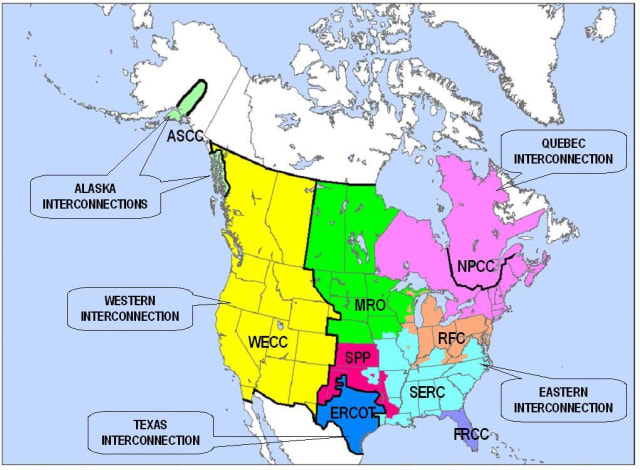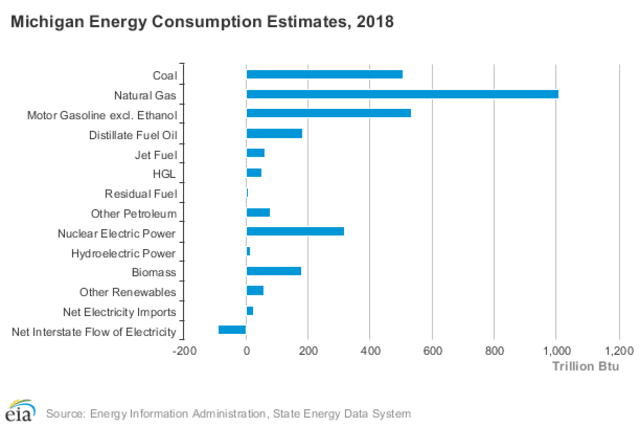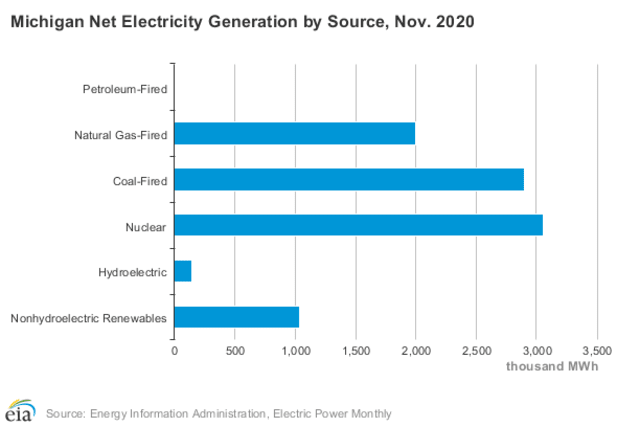DETROIT – Michigan has a diverse array of energy sources -- and it’s changing.
Unlike Texas, Michigan does not operate on its own, independent power grid. It is part of the North American Electric Reliability Corporation (NERC) grid, but wait -- it gets more complicated.
There are two major grids in the U.S. -- the Eastern and Western Interconnection. Michigan is on the Eastern. But inside of the Eastern are regional entities. Stay with me.
Michigan is included in the regional entity ReliabilityFirst (RFC) grid. This is all part of the NERC grid.

On top of this, Michigan is also managed by the Midcontinent Independent System Operator (MISO), an independent, not-for-profit organization that delivers electric power across 15 U.S. states and the Canadian province of Manitoba. Essentially, they operate as a reliability partner.
Related: What Michigan’s future could look like without action on climate change
Of course, Michigan is also generating its own power sources. Here’s a look at where we’re generating it, according to the U.S. Energy Information Administration (EIA):
First, some quick Michigan energy facts:
- Michigan has almost 1.1 trillion cubic feet of underground natural gas storage capacity, more than any other state and more than one-ninth of the nation’s total.
- In 2019, coal fueled the largest share of Michigan’s electricity generation, about 32%, and natural gas-fired generation exceeded nuclear power’s contribution for a second year in a row and rose to 30%.
- In 2019, renewable resources provided more than 8% of Michigan’s electricity net generation, with 60% of that provided by wind. Michigan ranks 15th among the states in wind-powered electricity generation.
- In 2018, Michigan was among the top five states in residential sector petroleum use and had the largest residential sector hydrocarbon gas liquids (mostly propane) consumption in the nation.
- Michigan’s largest hydroelectric facility is the Ludington pumped-storage plant on the shores of Lake Michigan on the Lower Peninsula. With a nameplate generating capacity of more than 2,000 megawatts, it is one of the largest pumped storage power plants in the world.

Natural gas
The Antrim Field in the northern portion of the Lower Peninsula contains most of Michigan’s natural gas reserves, and the state holds about 0.3% of the U.S. proved natural gas reserves, according to the U.S. Energy Information Administration (EIA).
Although there are more than 9,300 producing natural gas wells in the state, Michigan’s natural gas production has declined from its 1997 peak of more than 311 billion cubic feet per year to less than 90 billion cubic feet in 2018, the EIA reports.
According to EIA, Michigan has the largest underground natural gas storage capacity in the nation at nearly 1.1 trillion cubic feet, more than one-ninth of the U.S. total. The state also has the second-largest number of natural gas storage fields, second only to Pennsylvania.
During high demand periods, typically between November and April, natural gas is withdrawn from storage to meet increased demand for use in space heating. Much smaller amounts of natural gas are withdrawn from storage in summer when natural gas-fueled power generation increases to meet cooling demand.
According to EIA, In 2018, Michigan’s total natural gas consumption was almost 11 times greater than the state’s natural gas production. The residential sector, where more than three-fourths of Michigan households use natural gas as their primary source for home heating, is the largest natural gas consumer in the state.
Michigan routinely ranks among the top five states in residential use of natural gas and in the top 10 for total natural gas consumption by all sectors combined. The electric power sector is the second-largest consumer of natural gas in the state and has been since 2016.
In 2019, natural gas provided three-tenths of the state’s electricity generation, exceeding nuclear power’s contribution for the second year in a row.
Coal
Michigan has a small amount of economically recoverable coal reserves, but there are no active coal mines in the state.
Related: Whitmer sets goal to make Michigan carbon-neutral by 2050
In 2018, more than 26 million tons of coal were consumed in Michigan, with more than nine-tenths of it used by the electric power sector. Coal is also used to produce the coke consumed in steelmaking and some is used by other industrial and commercial consumers in Michigan.
Most of the coal consumed in Michigan comes by rail from the West, primarily from Wyoming and Montana but also Colorado. Coal also arrives from nearby states, including Pennsylvania, West Virginia, Virginia, Kentucky, and Indiana, according to EIA.
Electricity
Coal fuels the largest share of Michigan’s electricity generation, and 4 of the 10 largest power plants in the state are coal-fired. However, generating units at a dozen coal-fired power plants have been retired in the past decade and no new coal-fired facilities have been added or proposed.

In 2019, coal fueled nearly one-third of the state’s net generation, down from about half five years earlier, EIA estimates show.
Natural gas-fired power plants’ share of Michigan’s electricity generation almost tripled in the same period. In 2019, natural gas provided three-tenths of the state’s electricity generation, exceeding nuclear power’s contribution for the second year in a row.
Michigan’s three nuclear power plants typically supply slightly more than one-fourth of the state’s net generation.
Renewables
Renewable energy resources are used to generate about 8% of Michigan’s electricity, according to EIA estimates.
Most of the state’s renewable electricity generation comes from wind. In 2013, wind energy surpassed hydropower and biomass for the first time and became Michigan’s largest source for renewable generation. In 2019, wind energy supplied three-tenths of the state’s renewable generation and almost 5% of Michigan’s total in-state electricity generation from all sources.
Estimates of Michigan’s potential generating capacity from wind have increased with improved turbine technologies and greater turbine heights.
Michigan is among the top 15 states in the nation in terms of both capacity and generation from wind energy. The state has more than two dozen wind farms with a total generating capacity in excess of 2,100 megawatts.
Many of Michigan’s wind farms are located between Saginaw Bay and Lake Huron in the eastern part of the state’s Lower Peninsula.
Petroleum
Michigan’s crude oil reserves and production are modest. The state’s crude oil reserves account for less than 0.1% of the nation’s total reserve base, and Michigan’s production accounts for less than 0.2% of the U.S. total.
Michigan is among the top 11 states in total petroleum consumption. Four-fifths of the state’s petroleum use is in the transportation sector, and motor gasoline accounts for two-thirds of Michigan’s total petroleum consumption, EIA estimates show.
The commercial sector accounts for most of the rest of the state’s petroleum consumption. A small amount is used for electricity generation.
Dig deeper into Michigan energy data here, if you want to!




